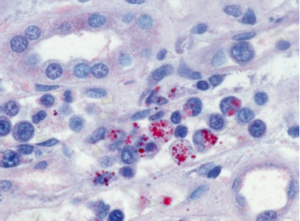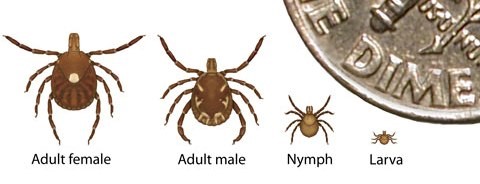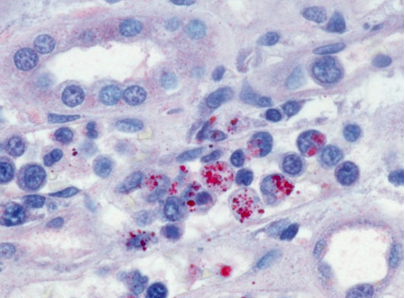
Ehrlichia species are bacteria that can evade the immune system and infect host cells. They preferentially infect white blood cells in the bloodstream, such as neutrophils and macrophages, but have also been found in spleen, lymph node, and kidney tissue samples. An infection caused by Ehrlichia species is generally referred to as ehrlichiosis.
Human ehrlichiosis is caused by three species found in the United States. Reported cases are primarily caused by Ehrlichia chaffeensis, but E. ewingii and E. muris eauclairensis (previously named Ehrlichia muris-like agent) infections have also been reported. According to the CDC, the number of ehrlichiosis cases caused by E. chaffeensis has increased steadily since 2000, with 1,642 cases reported in 2017. Fifty percent of new cases in the United States were reported in New York, Arkansas, Missouri, and Virginia.
The prevalence of Ehrlichia species varies depending on the geographic region. E. chafeensis and E. ewingii are found in the Eastern half of the United States extending from the coast to Texas, and 30% of United States cases are reported in Oklahoma, Missouri, and Arkansas. Ehrlichiosis caused by E. eauclairensis has only been reported in Minnesota and Wisconsin.
Transmission
Ehrlichia species are primarily transmitted via bites from infected ticks. Ticks become infected when they feed on animals that host the bacteria without experiencing clinical symptoms (reservoirs). These reservoirs are typically mammals, but the species varies depending on the geographic region. E. chaffeensis and E. ewingii are thought to be hosted primarily by different species of mice in the United States and throughout Europe. Research shows that other small rodents, such as voles, can also act as reservoirs.
The primary tick vectors for Ehrlichia species are the Lone Star tick (Amblyomma americanum) and the blacklegged tick (Ixodes scapularis). The Lone Star tick resides in the Eastern half of the country and is frequently found on the East Coast and in the Southeast. The blacklegged tick has an even wider range and has been shown to transmit other tick-borne pathogens such as Borrelia and Anaplasma. Research has shown that additional Ixodes species, such as Ixodes ricinus in Europe, may transmit Ehrlichia species as well.

Although the vast majority of ehrlichiosis cases are caused by tick bites, symptoms have been observed to occur after a blood transfusion or organ transplant. According to the CDC, there have been two confirmed instances of infection occurring after kidney transplants from a common donor.
Symptoms
The non-specific and chronic symptoms associated with ehrlichiosis often mimic other chronic infections and autoimmune diseases. Ehrlichiosis infection can also mimic liquid tumors. The clinical presentations can range from mild to severe illness. Being aware of a recent tick attachment and whether Ehrlichia is endemic to the region is helpful for diagnosis.
The following list presents common (but not all) symptoms:
- Fever with chills
- Headache
- Malaise
- Myalgia
- Gastrointestinal symptoms (nausea, vomiting, diarrhea, anorexia)
- Confusion
- Rash
The clinical signs for patients who are immunocompromised or have co-infections may be more severe.
References
Blanco, J. R., & Oteo, J. A. (2002). Human granulocytic ehrlichiosis in Europe. Clinical Microbiology and Infection, 8(12), 763-772. https://www.ncbi.nlm.nih.gov/pubmed/12519349
Centers for Disease Control and Prevention. (2019). Ehrlichiosis epidemiology and statistics. Retrieved from: https://www.cdc.gov/ehrlichiosis/stats/index.html
Ismail, N. et al. (2010). Human ehrlichiosis and anaplasmosis. Clinics in Laboratory Medicine, 30(1), 261-292. doi:10.1016/j.cll.2009.10.004 https://europepmc.org/articles/pmc2882064
Malani, A. et al. (2005). Ehrlichiosis mimicking T-cell lymphoma/leukemia. Blood, 106, 4343. Retrieved from: http://www.bloodjournal.org/content/106/11/4343
Snowden, J., & Simonsen, K. A. (2019). Ehrlichiosis. Retrieved from: https://www.ncbi.nlm.nih.gov/books/NBK441966/


